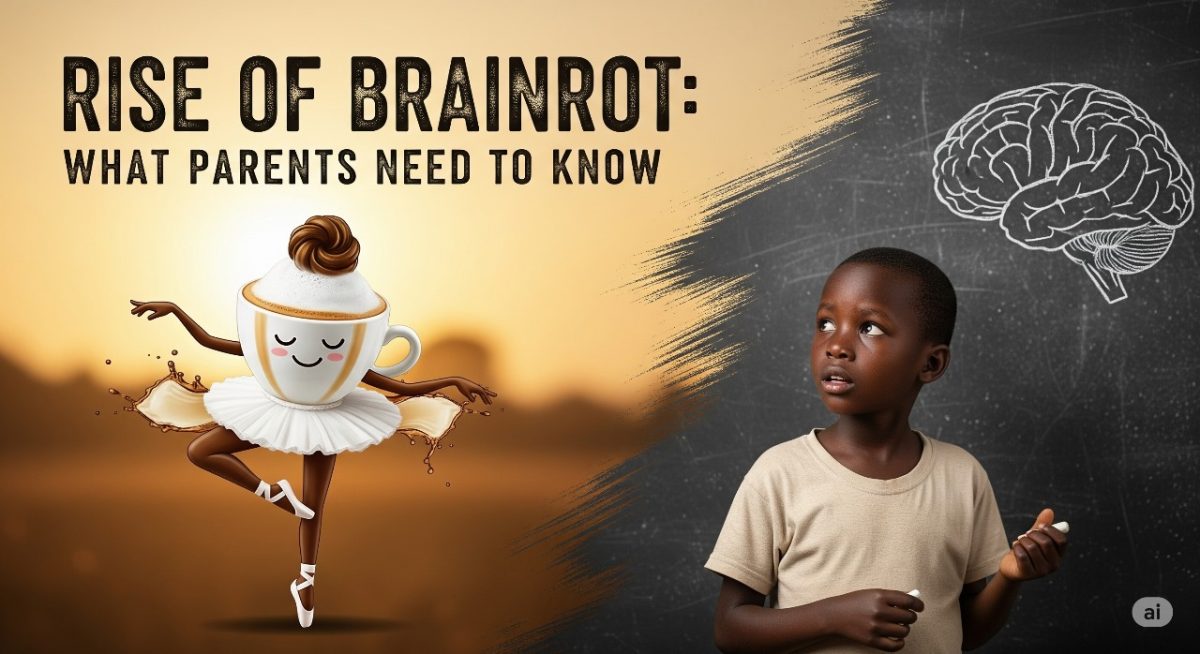Written by Jermaine Magethe
Your child is laughing at a cartoon fish with human legs who’s giving dating advice. A flying crocodile drops hearts on a mushroom. The song is in gibberish, but your child is chanting along: What is the stigma? Ts pmo!” You ask them what it means. They don’t know either. But they repeat it anyway.
Welcome to the world of brainrot.
Brainrot isn’t a diagnosis. It’s the name given to a growing genre of TikTok and YouTube content designed to be loud, chaotic, and meaningless. It’s especially popular with children under 13. Think of it as emotional junk food: sugary, colorful, addictive, and very confusing.
These videos often look like educational cartoons. They are filled with bouncy music, bright animations, and friendly voices. But instead of teaching shapes, letters, or empathy, they teach nothing at all. Or worse, they mix messages in ways that leave young viewers emotionally scrambled.
In one viral video, a cappuccino cup wearing a pink ballerina skirt spins on stage while shouting about jealousy and revenge. In another, a dolphin proposes marriage to a crab before exploding into candy. The visuals are dreamlike. The logic is broken. And children can’t stop watching.
The language in these videos follows the same pattern. Words are mashed together for rhythm or shock value. Some examples now common among Kenyan tweens include:
- “Huak tuah” (a misheard phrase from a viral video now used as a silly shout)
- “What the siigma” (a remix of “what the sigma,” often said with fake confusion)
- “Ts pmo” (slurred slang for “that’s so funny, I’m crying”)
- “Skibidi toilet” (an actual YouTube series where toilets with heads sing opera)
- “Grimace shake” (a McDonald’s mascot turned horror meme)
- “Rizzler king” (used to describe someone with romantic confidence, usually said ironically)
- “You just got gyatt’d” (nonsense based on the exaggerated way “got” is pronounced in meme videos)
For children, especially those aged 5 to 12, this is more than just silly fun. It can distort how they understand emotions, relationships, and storytelling.
Why? Because children learn through patterns. When characters are rewarded for being chaotic, mean, or violent, children absorb those messages. When love stories are told through revenge, or friendship is shown through trickery, children start to believe that’s normal. And when everything is sped up, turned into a joke, and repeated in neon colors, the real world begins to feel too slow.
This kind of content doesn’t break platform rules. It isn’t offensive or violent in the traditional sense. That’s what makes it so hard to regulate. But the effects are real. Teachers report students using brainrot phrases in class. Parents hear them at the dinner table. And yet, most adults have no idea what these words mean or where they come from.
In Kenya, where smartphone access has expanded and children are spending more time online, the effects are starting to show. Parents who don’t speak “brainrot” are left confused, thinking it’s just a phase or harmless internet play. But without guidance, children may absorb more than just words; they’re absorbing a worldview.
What can be done?
First, don’t panic. This isn’t about banning cartoons. It’s about understanding what children are watching, and talking to them about it. Ask them what their favorite videos are. Watch together. Pause and ask, “What do you think that character is feeling?” or “Was that kind or hurtful?”
Second, offer better content. Platforms like Mtoto News, Akili Kids, African Storybook, and National Geographic Kids provide entertaining, thoughtful material that sparks curiosity without overwhelming the senses.
Third, limit overstimulation. Not every free moment needs to be filled with flashing screens. Encourage slow play, drawing, storytelling, and other forms of creative boredom.
Finally, trust that your curiosity matters. You don’t need to speak in a brainrot to protect your child from it. You just need to be present, interested, and willing to explore their digital world with them.
In the end, the internet can still be a place of wonder. But only if we stay close enough to help our children make sense of it.

